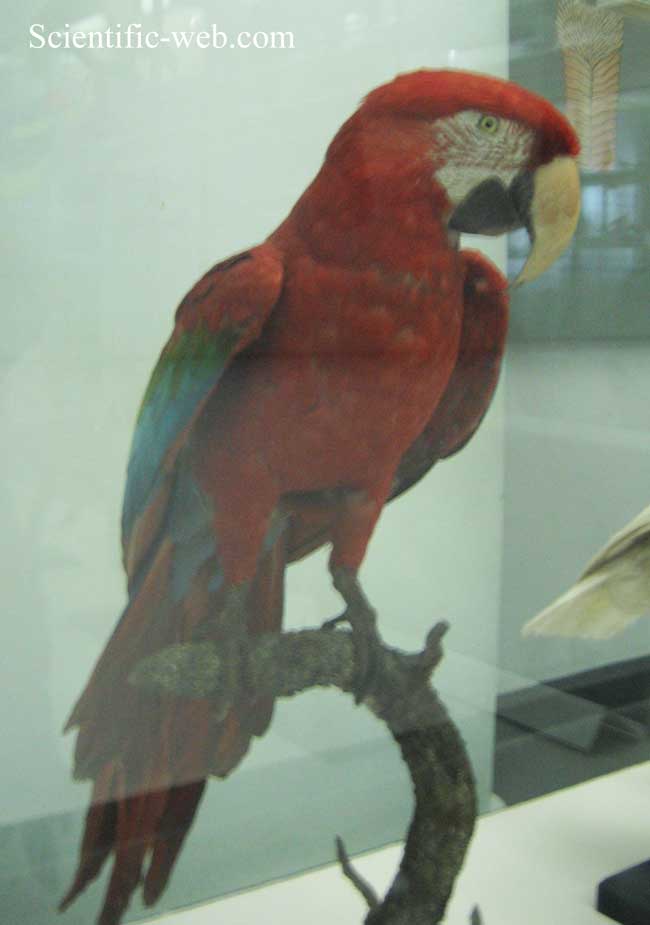
Ara chloropterus, Photo: Michael Lahanas
Superregnum: Eukaryota
Cladus: Unikonta
Cladus: Opisthokonta
Cladus: Holozoa
Regnum: Animalia
Subregnum: Eumetazoa
Cladus: Bilateria
Cladus: Nephrozoa
Superphylum: Deuterostomia
Phylum: Chordata
Subphylum: Vertebrata
Infraphylum: Gnathostomata
Megaclassis: Osteichthyes
Cladus: Sarcopterygii
Cladus: Rhipidistia
Cladus: Tetrapodomorpha
Cladus: Eotetrapodiformes
Cladus: Elpistostegalia
Superclassis: Tetrapoda
Cladus: Reptiliomorpha
Cladus: Amniota
Classis: Reptilia
Cladus: Eureptilia
Cladus: Romeriida
Subclassis: Diapsida
Cladus: Sauria
Infraclassis: Archosauromorpha
Cladus: Crurotarsi
Divisio: Archosauria
Cladus: Avemetatarsalia
Cladus: Ornithodira
Subtaxon: Dinosauromorpha
Cladus: Dinosauriformes
Cladus: Dracohors
Cladus: Dinosauria
Ordo: Saurischia
Cladus: Eusaurischia
Subordo: Theropoda
Cladus: Neotheropoda
Cladus: Averostra
Cladus: Tetanurae
Cladus: Avetheropoda
Cladus: Coelurosauria
Cladus: Tyrannoraptora
Cladus: Maniraptoromorpha
Cladus: Maniraptoriformes
Cladus: Maniraptora
Cladus: Pennaraptora
Cladus: Paraves
Cladus: Eumaniraptora
Cladus: Avialae
Infraclassis: Aves
Cladus: Euavialae
Cladus: Avebrevicauda
Cladus: Pygostylia
Cladus: Ornithothoraces
Cladus: Ornithuromorpha
Cladus: Carinatae
Parvclassis: Neornithes
Cohors: Neognathae
Cladus: Neoaves
Cladus: Telluraves
Cladus: Australaves
Ordo: Psittaciformes
Familia: Psittacidae
Subfamilia: Arinae
Tribus: Arini
Genus: Ara
Species: Ara chloropterus
Name
Ara chloropterus G.R. Gray, 1859
Synonyms
Ara chloroptera (orth. err.)
References
List of the specimens of birds in the collection of the British Museum 3 (2): p. 26 BHL.
Vernacular names
Deutsch: Grünflügelara
English: Red-and-green Macaw
español: Guacamaya Alaverde
suomi: Vihersiipiara
français: Ara chloroptère
magyar: Zöldszárnyú ara
italiano: Ara aliverdi
日本語: ベニコンゴウインコ
norsk: Mørkerød ara
polski: ara zielonoskrzydła
português: Arara-vermelha
svenska: Mörkröd ara
The red-and-green macaw (Ara chloropterus), also known as the green-winged macaw,[2] is a large, mostly-red macaw of the genus Ara.
This is the largest of the genus Ara, widespread in the forests and woodlands of northern and central South America. However, in common with other macaws, in recent years there has been a marked decline in its numbers due to habitat loss and illegal capture for the parrot trade.[3]
Description
The green-winged macaw can be readily distinguished from the scarlet macaw. While the breast of both birds are bright red, the upper-wing covert feathers of the green-winged macaw is mostly green (as opposed to mostly yellow, or a strong mix of yellow and green in the scarlet macaw). In addition, the green-winged macaw has characteristic red lines around the eyes formed by rows of tiny feathers on the otherwise bare white skin patch; this is one of the biggest differences from a scarlet macaw to the casual viewer. Iridescent teal feathers are surrounded by red on the tail. If seen together, the green-winged macaw is clearly larger than the scarlet macaw as well.
In terms of length, this species is second only in size to the hyacinth macaw, the largest of the macaws. The red-and-green macaw attains a total body length of 90 to 95 cm (35 to 37 in) in adults.[4] Twelve adults were found to average 1,214 g (2.676 lb).[5] A weight range of between 1,050 and 1,708 g (2.315 and 3.765 lb) has been reported.[4] While its weight range is broadly similar to that of the hyacinth, the average weight of the red-and-green macaw is slightly surpassed by both the hyacinth and great green macaws, and amongst all living parrots additionally by the kakapo.[4][5]
Behavior
The green-winged macaw generally mates for life.[6] The female typically lays two or three eggs in a nest made in a hole in a tree. The female incubates the eggs for about 28 days, and the chicks fledge from the nest about 90 days after hatching.[7]
Population recovery
Since 1999 a population has appeared on Trinidad. Although these might have escaped from captivity, it is also possible they have a wild origin.[8]
The historical range of this species is thought to have stretched southwards to include the Argentine provinces of Chaco, Corrientes, Formosa and Misiones. Hunting for meat, the pet trade and changes in land use are thought to have caused the species to be extirpated throughout its Argentine range by the 1960s. The species is listed as critically endangered in Argentina. In the mid-2010s birds were discovered to have colonised Iguazú National Park, and as of 2019 the species appears to have spread further into nearby Parque provincial Puerto Península.[9]
The species is furthermore the subject of a re-introduction programme to Iberá Provincial Reserve in the province of Corrientes by the World Parrot Trust, Aves Argentinas and Fundación CLT (Conservation Land Trust) (and perhaps BirdLife International), which is hoped may promote tourism to the area. Captive birds from Britain were imported in 2015 and the first pair of British birds was released in February 2019.[9][10] Its wild population is estimated to be currently between 50,000 and 100,000 individuals.
References
BirdLife International (2016). "Ara chloropterus". IUCN Red List of Threatened Species. 2016: e.T22685566A93080287. doi:10.2305/IUCN.UK.2016-3.RLTS.T22685566A93080287.en. Retrieved 11 November 2021.
"Red-and- Green Macaw". Avibase.
"Ara chloropterus (Red-and-green macaw)". IUCN Red List. IUCN. 1 October 2016. Retrieved 26 April 2020.
Cameron, M. (2012). Parrots: the animal answer guide. JHU Press.
CRC Handbook of Avian Body Masses, 2nd Edition by John B. Dunning Jr. (Editor). CRC Press (2008), ISBN 978-1-4200-6444-5.
"Green-winged Macaw". The Maryland Zoo. Retrieved 2019-05-30.
Alderton, David (2003). The Ultimate Encyclopedia of Caged and Aviary Birds. London, England: Hermes House. p. 235. ISBN 1-84309-164-X.
"Red-and-green Macaw Page". Southeastern Caribbean Birds - Photo Gallery. Trinidad and Tobago Field Naturalists' Club, Trinidad & Tobago Bird Status & Distribution Committee. 27 February 2001. Retrieved 17 August 2019.
Escobar, Patricia (5 May 2019). "Registraron un Guacamayo rojo, especie en peligro de extinción en el país, en su vuelo en libertad por el Parque Provincial Pto. Península". Argentina Forestal (in Spanish). Retrieved 16 August 2019.
"BirdLife Macaws return to Argentina". BirdGuides. Retrieved 12 November 2015.
Retrieved from "http://en.wikipedia.org/"
All text is available under the terms of the GNU Free Documentation License

